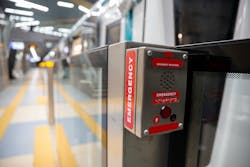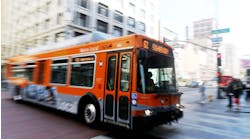Transit security teams are responsible for keeping commuters and transit employees safe day in and day out. It’s a complex task to monitor busy transit stations, passengers and fleets. Here are three best practices to prioritize to keep transit operations running efficiently and securely.
1. Unify on-board and building security
In the past, transit operations often required stitching together different systems to manage routing, video, access control and more. Modern unified security solutions enable a holistic view, bringing together data from buses, buildings and other system elements into the same software interface.
When data and monitoring are centralized within one system, it’s easier for operators to proactively monitor security throughout the transit network. Data from cameras and sensors can even be plotted on a map for an intuitive location-based view, making it easier to find the data needed.
2. Collaborate with community partners
When there is a threat of violence, a speedy response is critical. A unified approach to transit security makes sharing data with community partners faster and more secure.
Operators can create automations aligned with standard operating procedures to alert local law enforcement and transit police departments. For example, when the system detects a critical incident, such as an alert from a gunshot detector or a driver pressing a panic button, automated procedures can trigger a response. The action could entail notifying law enforcement, streaming live video to a security operations center or other predefined steps.
After an incident, cloud-based digital evidence management systems make it easy to collect and share video or other evidence with stakeholders such as investigators, legal teams or community members who submit freedom of information requests. The system can also blur the faces of bystanders to protect privacy. Your team can control access through authentication and authorization, and a chain of custody report shows who has viewed, shared, downloaded, uploaded or deleted files.
3. Leverage ALPR to improve operations
Unified security platforms make it easier to effectively incorporate technologies such as automatic license plate recognition (ALPR) analytics to improve safety and streamline operations.
On-board cameras can capture the license plate details of cars parked illegally in bus lanes or driving in dedicated bus lanes. Reviewing video can help authorities determine whether the driver violated the rules. These incidents can be hard to enforce without constant patrols, yet actions like these can result in significant delays for buses and be safety hazards.
ALPR can also be deployed in partnership with law enforcement. Cameras on buses and at transit stations to help police locate vehicles that have been linked to Amber Alerts, watchlists or other incidents of crime.
Ongoing innovation
As technology evolves, there will be more opportunities to streamline transit operations. Open architecture, unified solutions allow systems to grow and be enhanced as needs evolve and new solutions are introduced. The result is a better customer experience. Riders get to their destinations safely and on time and teams work more efficiently and proactively, knowing their systems are running smoothly and securely.




